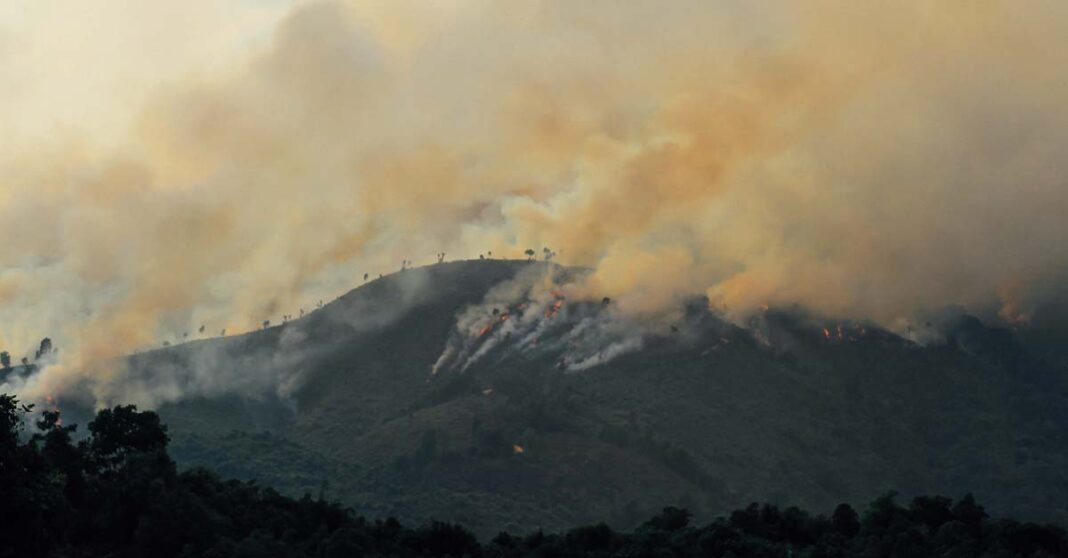Agricultural practices and fires are major contributors to air pollution in Laos, writes Nasar Hayat, UN FAO Representative to Laos in an Op-ed.
A recently conducted study by the Food and Agriculture Organization of the United Nations (FAO), shows that climate, agriculture production, and fire are the key drivers of air pollution in Laos, with the northern part of the country consistently showing more fire activity.
Luang Prabang, Oudomxay, Huaphan, Xayaboury, and Phongsaly provinces are forest fire hotspots, with Luang Prabang, Xayaboury, Vientiane, Savannakhet, and Oudomxay provinces being crop fire hotspots.
Across the world, scientists now agree that atmospheric pollution has been causing a significant impact on climate, both at the local (through phenomena such as smog and haze), and the global levels (through climate change). Due to changes in local weather patterns, such as rainfall and temperature, atmospheric pollution also affects agricultural production.
Equally important, air pollution is detrimental to the health of the population. According to the World Health Organization (WHO), household and ambient pollution caused seven million deaths in 2016, with 94% of these deaths occurring in low and middle-income countries. The air pollution burden of South-East Asia is among the highest in the world. In 2016, an estimated 2.4 million premature deaths were attributed to air pollution. Exposure to air pollution is linked to lung cancer, lower respiratory diseases, chronic obstructive pulmonary diseases, and heart diseases.
Laos is one of the most vulnerable countries to be potentially affected by climate change. These impacts are expected to be enhanced by the poverty and malnourishment faced by communities across the country, especially during the recent economic slowdown. Laos has joined numerous conventions, policies, and frameworks, including the United Nations Framework Convention on Climate Change (UNFCCC) to work on the mitigation and adaptation to climate change through actions that focus, amongst others, on the reduction of air pollution.
To support Laos in its efforts, FAO conducted a multi-year study on air pollution and its main causes. The study, titled Spatio-Temporal Dynamics of Air Pollution and Potential Drivers in Laos, collected data from 2015 to 2021. Multiple stakeholders, particularly the Environmental Statistics and Research Institute (NRESRI), the Ministry of Natural Resources and Environment (MONRE), as well as various other government agencies of Laos, provided significant inputs and cooperation to this effort.
The FAO study used several atmospheric pollution indicators (nitrogen dioxide (NO2), sulfur dioxide (SO2), ozone (O3), aerosol optical depth (AOD), and the ultraviolet aerosol index (UVAI) to analyze the dynamics of atmospheric pollution in Laos and to determine the corresponding pollution hotspots. A variety of the sources and drivers of pollution were investigated including climate variables, population, transport, industrial activity, biomass burning, and agricultural production. National, zonal and provincial levels were analyzed at seasonal, monthly, and yearly intervals.
The FAO study determined that air pollution in Laos is mainly caused by climate, agricultural production, and fire activity. The levels of air pollution peak during the dry season and are relatively higher in the northern and central parts of the country. The study found that the peaks in air pollution coincide with the main fire season, which occurs in the months from February through May, with peaks in March and April.

Four Northern Provinces Identified as Major Pollution Hotspots
Four provinces in the north (Bokeo, Phongsaly, Oudomxay, and Luang Prabang) and Savannakhet in the south, were identified as overall pollution hotspots.
According to the findings, forest fires, agricultural fires, and slash-and-burn practices are significant contributors to air pollution. Laos experiences a huge number of forest fires, especially in the north, with the province of Luang Prabang having the highest number of forest fire events in the country.
The provinces of Luang Prabang, Savannakhet, and Oudomxay were identified as cropland fire hotspots, along with Xayabury and Vientiane. Furthermore, analysis revealed the potential presence of deforestation following slash-and-burn activities.
The study has also found signs of transport of air pollution from neighboring countries (including those immediately adjacent to Laos and those farther away), which undergo recurrent agricultural burning.
Additionally, the study made a series of recommendations in order to help Laos improve its efforts to monitor air pollution and develop insights for the mitigation of climate change and its impacts.
Specifically, it is suggested that the country enhances technical capacities in the application and analysis of the latest technologies and approaches for the measurement and monitoring of air pollution in Laos. A centralized platform with cross-sectorial data-sharing protocols and field collection campaigns, supported with innovative techniques to fill in the gaps of atmospheric pollution, would have the potential to accelerate actions for air pollution reduction.
It would also be beneficial to provide support to national pro-poor intervention plans to ensure that the most vulnerable members of the population, in particular farmers, are not negatively impacted by emission reduction policies. Awareness raising and capacity development are crucial to increase awareness about the impacts of air pollution and open burning. Moreover, promoting the adoption of sustainable and resilient land management practices by farmers (e.g., low-level agricultural burning, chipping, and mulching) has the potential to reduce emissions.
Equally important, Laos23 would benefit from the development of evidence-based policies on pollution and the collaboration with other members of ASEAN countries to track and reduce transboundary pollution.
FAO hopes that the collected evidence will be used by decision-makers in the government and other stakeholders to monitor air pollution and inform the design of policies and actions directed at the reduction of air pollution in the country. In particular, this study provides insights into national action plans for the reduction of air pollution emissions, including the Strategy on Climate Change of Laos; the Intended Nationally Determined Contributions (NDC) under UNFCCC; the Laos Agriculture Development Strategy to 2025 and Vision to 2030; and the National Socioeconomic Development Plan 2021-2025.
The views and opinions expressed in this article are those of the author and do not necessarily reflect the position of the Laotian Times.



